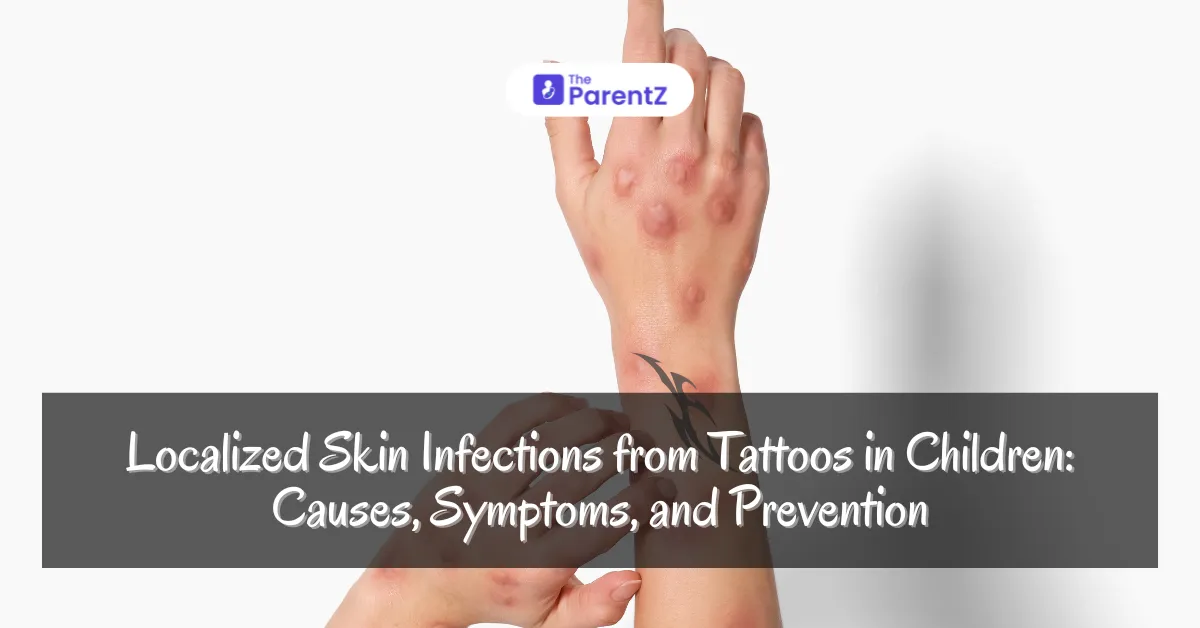Temporary and permanent tattoos are popular among children, but they come with risks, including localized skin infections. These infections can occur due to poor hygiene, allergic reactions, or contaminated ink. Understanding the causes, symptoms, prevention, and treatment of these infections is essential for parents to ensure their child’s safety.
What Are Localized Skin Infections?
Localized skin infections occur when bacteria, fungi, or other pathogens invade the skin at the tattooed area. In children, these infections are more likely due to their sensitive skin and underdeveloped immune systems.
Infections are most common with:
• Temporary tattoos: Often caused by contaminated adhesives or improper application.
• Permanent tattoos: Rare in children but can lead to bacterial infections if done with unsterile tools or ink.
Causes of Localized Skin Infections in Children
1. Contaminated Ink or Adhesives
• Infections may occur if tattoo ink or adhesives are contaminated with harmful bacteria.
2. Unhygienic Application
• Using non-sterile tools or unsanitary hands during tattoo application increases infection risk.
3. Sensitive Skin
• Children’s delicate skin is more prone to irritation and infections, even with non-toxic products.
4. Scratching or Picking
• Children may scratch or pick at tattoos, breaking the skin and introducing bacteria.
5. Allergic Reactions
• Allergic responses can weaken the skin barrier, making it easier for pathogens to invade.
Symptoms of Localized Skin Infections
• Redness and Swelling
• The skin around the tattoo appears red, inflamed, or puffy.
• Pain or Tenderness
• The area feels sore or tender to the touch.
• Pus or Discharge
• Yellow or green fluid may ooze from the tattooed area, indicating an infection.
• Blisters or Sores
• Small blisters or open sores may develop at the site.
• Fever (Rare)
• In severe cases, a child may develop a mild fever.
How to Prevent Localized Skin Infections in Children
1. Choose Safe Products
• Use hypoallergenic, dermatologist-approved tattoo products for temporary tattoos.
• Avoid black henna, which often contains harmful chemicals.
2. Ensure Hygienic Application
• Wash hands thoroughly before applying tattoos.
• Use clean and sterile tools during the process.
3. Patch Testing
• Perform a patch test on a small area of skin 24 hours before applying a tattoo.
4. Educate the Child
• Teach children not to scratch or rub the tattooed area.
• Ensure they wash their hands before touching the tattoo.
5. Limit Exposure
• Avoid swimming pools, hot tubs, or dirty environments after applying a tattoo.
Treatment for Localized Skin Infections
1. Clean the Area
• Wash the tattooed area gently with mild soap and warm water.
• Pat it dry with a clean towel.
2. Topical Antiseptics
• Apply over-the-counter antiseptic ointments (e.g., Neosporin) to prevent bacterial growth.
3. Avoid Scratching
• Use soothing creams like calamine lotion or hydrocortisone to reduce itching and inflammation.
4. Monitor Symptoms
• Keep an eye on the infection for signs of worsening, such as increased redness, pus, or spreading.
5. Seek Medical Attention
• If symptoms persist or worsen after 48 hours, consult a doctor. A doctor may prescribe:
- Topical antibiotics: Mupirocin for bacterial infections.
- Oral antibiotics: For more severe infections.
When to Consult a Doctor
• Infection spreads beyond the tattooed area.
• The child develops a fever or systemic symptoms.
• There is persistent pain, swelling, or discharge.
Conclusion
While tattoos can be a fun way for children to express creativity, they can sometimes lead to localized skin infections if not applied or maintained properly. Parents must prioritize hygiene, perform patch tests, and monitor the skin for any signs of irritation or infection. Early intervention and treatment can help manage infections effectively and ensure a safe tattooing experience.
References
• American Academy of Dermatology. Skin infections and temporary tattoos.
• Centers for Disease Control and Prevention (CDC). Prevention of skin infections.
• National Institute of Allergy and Infectious Diseases (NIAID). Tattoo-related skin reactions.








Be the first one to comment on this story.